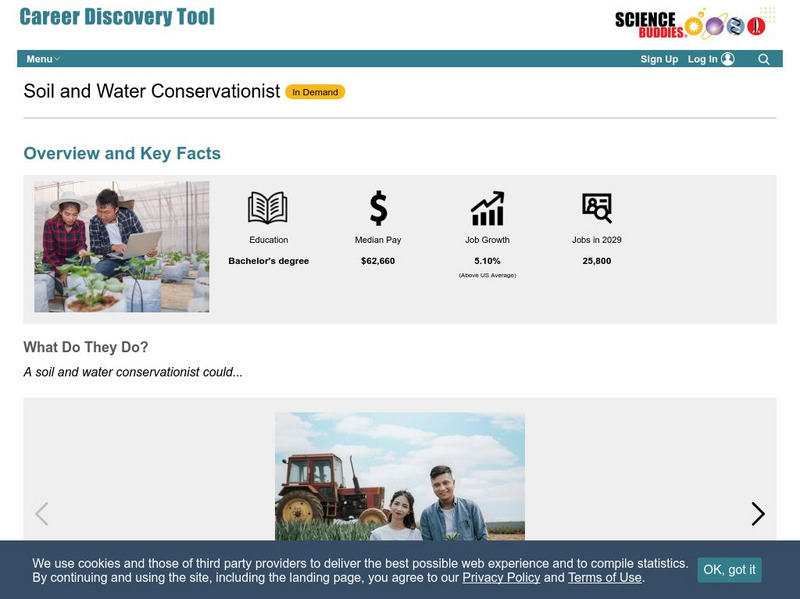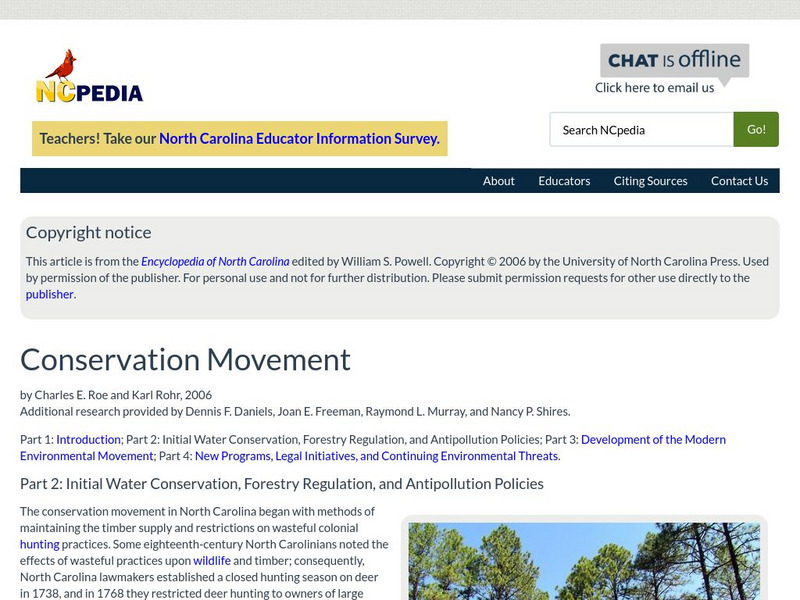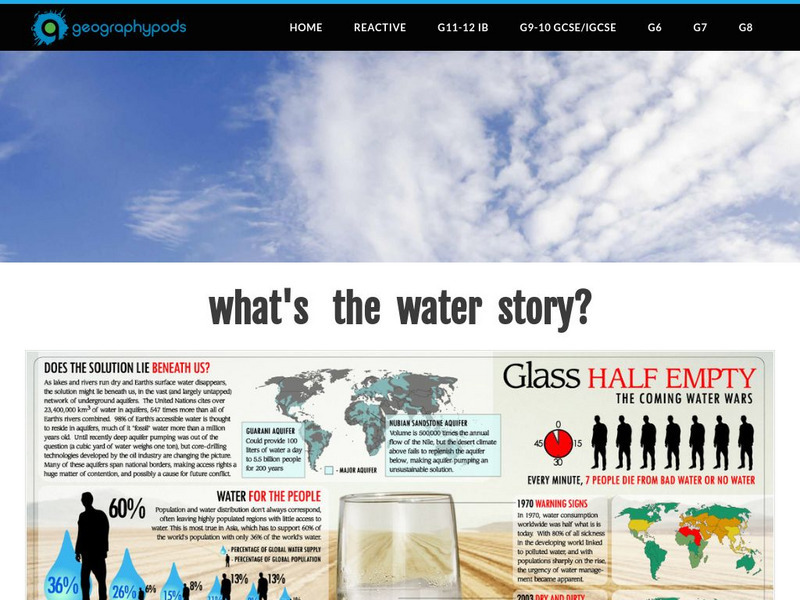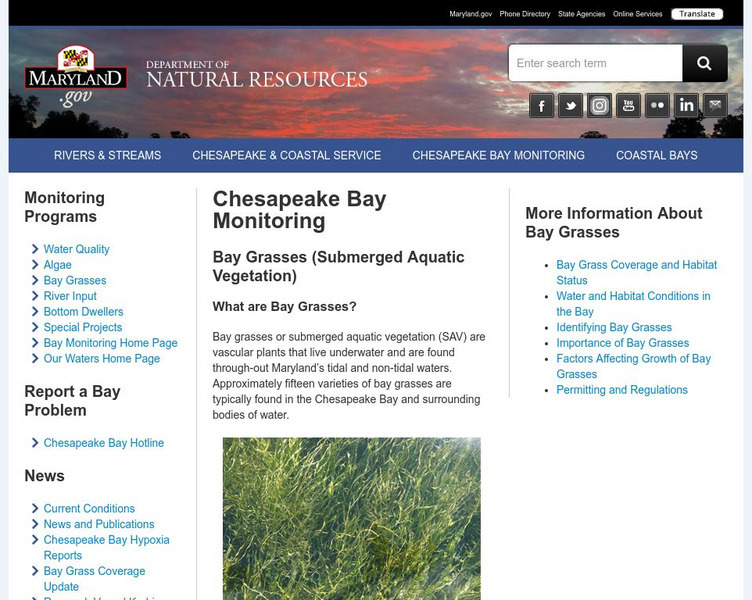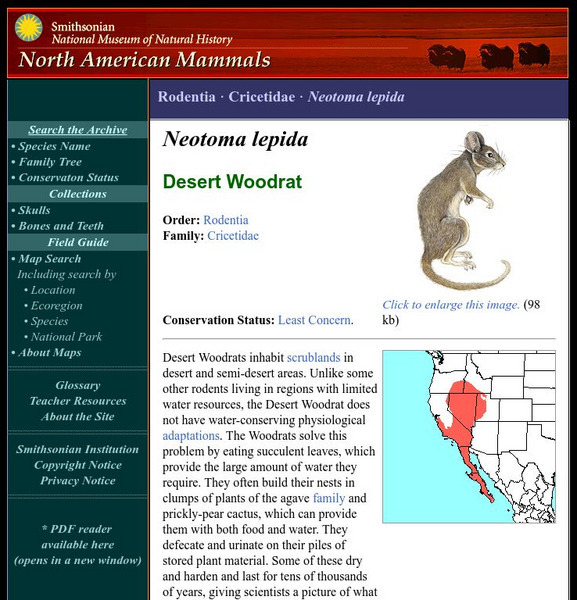Mocomi & Anibrain Digital Technologies
Mocomi: What Are Natural Resources?
Overview of the types of natural resources and a list of natural resources found in India.
eSchool Today
E School Today: Your Cool Basics on Water Shortage
Despite seventy percent of the world's surface being covered with water, there is a potential shortage of this natural resource. Only a small percentage is fresh water and much of that is inaccessible or threatened. Learn about fresh...
Science Buddies
Science Buddies: Career Profile: Soil and Water Conservationist
Soil and water conservation are important in the protection of the earth's natural resources. Read about the careers that study and encourage conservation. Find out about the educational requirements necessary to become a soil or water...
Other
North Carolina Department of Energy and Natural Resources: Grade Your Schoolyard
What is your school doing to protect and conserve water? Use the following questions to find out. When you are done, make some suggestions for how your school could improve. What could you and your class do to help?
Nature Conservancy
Nature Works Everywhere: How Natural Areas Filter Water
By studying nature's filters, students learn about the importance of water quality for human health and agriculture.[4 min, 6 sec] Includes lesson plan and student handouts.
University of Florida
Florida Museum of Natural History: Investigating Water
This guide engages children in the process of scientific inquiry using the context of a favorite early childhood pastime-water play.
Other
The World Counts: Are We Using Up More Than What Is Available?
A snapshot of what the world would be like if it lost crucial natural resources such as water, oil, and trees. Lists the causes and consequences, and ways people can make a difference.
Other
Florida Dept. Of Education: Conservation of Renewable and Nonrenewable Resources
In this learning module, students learn to differentiate between renewable and nonrenewable resources, and identify resources that fit into each category. It explains the environmental effects of using nonrenewable resources, such as...
TeachEngineering
Teach Engineering: The Other Water Cycle
For learners that have already been introduced to the water cycle, this lesson is intended as a logical follow-up. Students will learn about human impacts on the water cycle that create a pathway for pollutants beginning with urban...
Nature Conservancy
The Nature Conservancy: Gardens Activity Guide: Water
In this guide helps learners understand their garden as a model watershed through the collection and analysis of rainwater filtration data.[4.06]
State Library of North Carolina
N Cpedia: Conservation Movement: Water Conservation
The conservation movement in North Carolina began with methods of maintaining the timber supply and restrictions on wasteful colonial hunting practices. Some eighteenth-century North Carolinians noted the effects of wasteful practices...
Encyclopedia of Earth
Encyclopedia of Earth: Cape Verde
Facts about Cape Verde including environmental issues, geography, government, people, water, economy, agriculture, natural resources, and energy.
Encyclopedia of Earth
Encyclopedia of Earth: Burundi
Facts about Burundi including environmental issues, geography, government, people, water, economy, agriculture, health, natural resources, energy resources, and conflict.
Geographypods
Geographypods:freshwater: Issues and Conflicts: Competing Demands for Freshwater
This learning module examines conflicting demands for fresh water around the world. It looks at the water resources that are available, water scarcity, and local and international conflicts over water. Specific cases are explored,...
Other
Maryland Dnr: Chesapeake Bay Monitoring: Bay Grasses
This resource provides information about the marine grasses found in the Chesapeake Bay. Click on adjacent links to learn about their habitat, how to identify them, and why they are important.
Nature Conservancy
The Nature Conservancy: From America's Rainforest to America's Desert
On this virtual field trip, teachers will help their students travel to the lush, rain-soaked splendor of the Olympic Peninsula and explore the urban watershed of Seattle. Next, they will head to Arizona's dry, desert landscape and take...
Science Education Resource Center at Carleton College
Serc: Microbial Life: Los Angeles and the Future of Mono Lake: Web Quest
Student WebQuest studying biodiversity, preservation, and natural history. Students act as political advisors exploring Mono Lake's life forms the impact humans have on the environment. After researching the issues, students create a...
PBS
Pbs Learning Media: Liberty Lands
In this What's Up In The Environment? video segment, learn how a contaminated plot of land in Philadelphia was recycled into a beautiful public park called Liberty Lands.
Encyclopedia of Earth
Encyclopedia of Earth: Chad
Facts about Chad including environmental issues, geography, government, people, water, economy, agriculture, health, natural resources, energy use, and conflict.
Cosmo Learning
Cosmo Learning: The Atmosphere, the Ocean, and Environmental Change
A collection of video lectures from a course that explores the physical processes the control Earth's atmosphere, ocean, and climate that is taught at Yale University. The course covers topics like clouds, rain, severe storms, regional...
PBS
Pbs Teachers: Rivers of Destiny
This site explains the importance of rivers in the natural balance of life on Earth, and describes what happens when people begin to tamper with rivers. This will also help students identify options for dealing with the outcomes of human...
PBS
Pbs Learning Media: Exploring Environmental Change
Students explore the connections that can exist in a natural environment, and examine how changes to the environment, particularly those caused by human activity, can affect those connections.
Smithsonian Institution
National Museum of Natural History: American Mammals: Desert Woodrat
Desert Woodrats inhabit scrublands in desert and semi-desert areas. Unlike some other rodents living in regions with limited water resources, the Desert Woodrat does not have water-conserving physiological adaptations. Learn more about...


